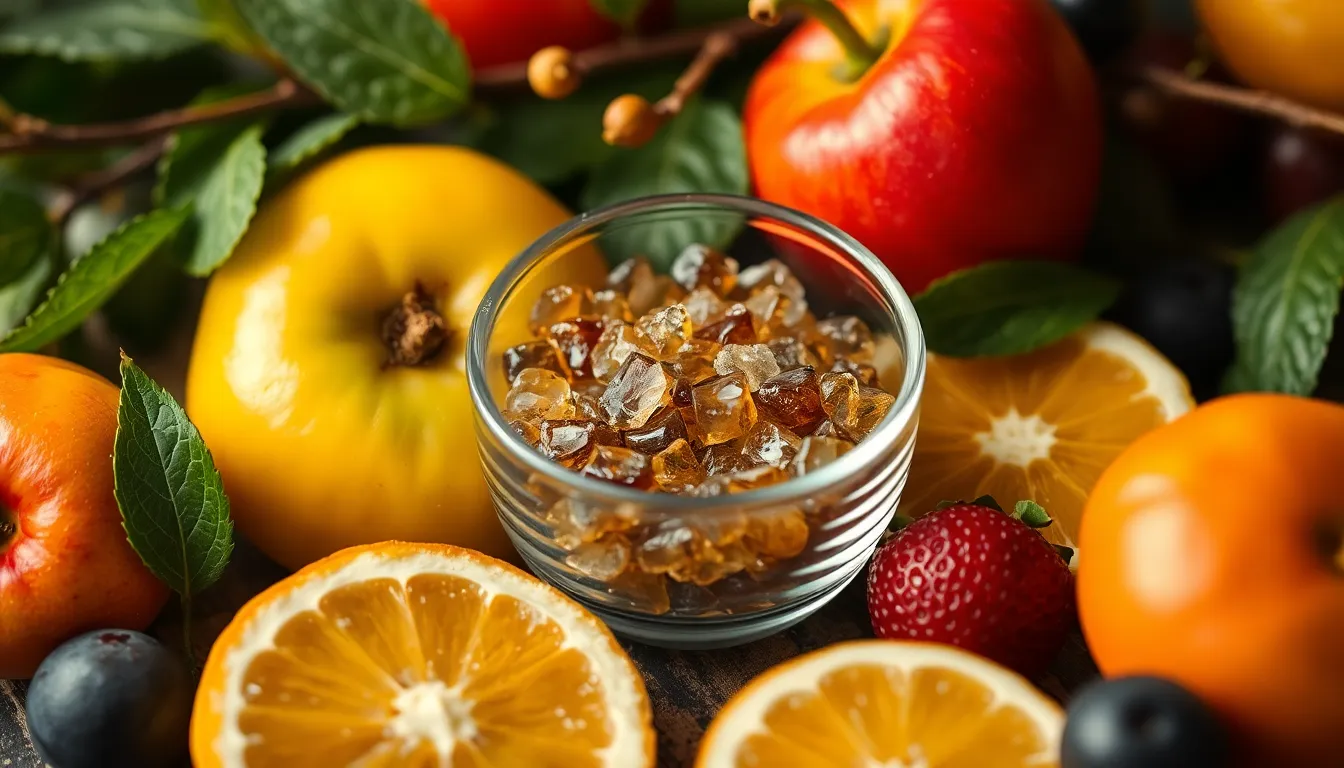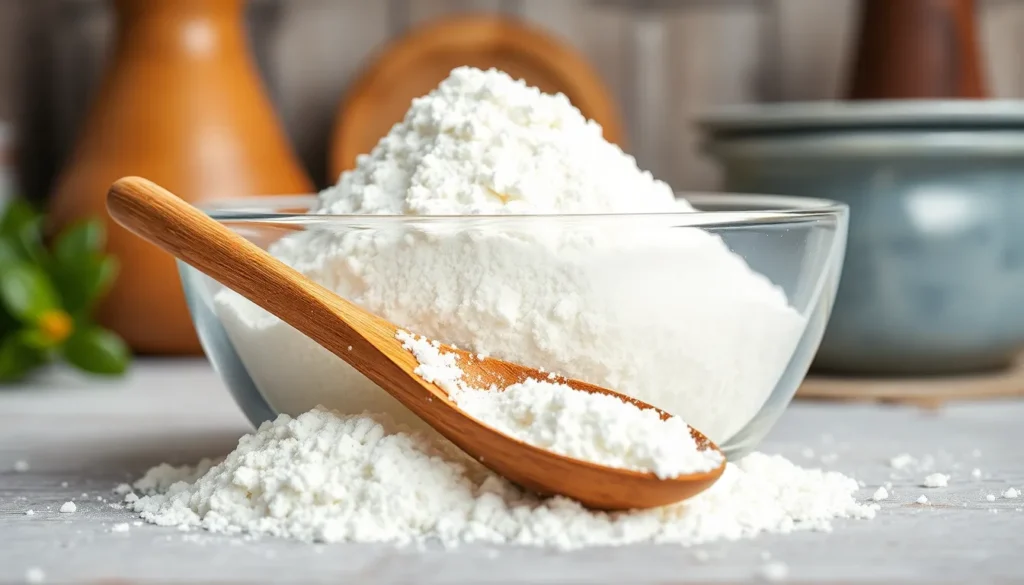Gellan gum might sound like something straight out of a sci-fi movie, but it’s actually a superstar in the food industry. This versatile ingredient is a plant-based gelling agent that’s become a favorite among chefs and food manufacturers alike. But what exactly is it made of? Spoiler alert: it’s not from some mysterious alien plant!
Table of Contents
ToggleWhat Is Gellan Gum Made Of?
Gellan gum consists primarily of a polysaccharide produced through fermentation. Specific strains of bacteria, particularly Sphingomonas elodea, play a pivotal role in its formation. These bacteria ferment sugars, converting them into gellan gum’s unique molecular structure.
Fermentation typically utilizes glucose or sucrose as substrates, which helps in creating the desired consistency and properties of gellan gum. Cultivating the bacteria in a controlled environment allows for an efficient production process, ensuring high purity and functionality.
Once produced, gellan gum undergoes a series of purification steps to isolate it from the fermentation medium. Purification removes impurities and results in a fine, white to yellowish powder. This powder is not only soluble in water but also has remarkable gelling properties that enhance various food applications.
Gellan gum can produce distinct textures depending on how it is processed. Depending on the presence of other ingredients, it can form firm gels or soft gels. Applications can range from jellies to dairy products, showcasing its versatility in food formulations. The ingredient serves as a stabilizer and thickener, contributing significantly to the overall sensory experience of food products.
End-products often require specific ratios and methods to achieve the desired texture. Notably, the gelling temperature and acidity levels influence how gellan gum interacts with other ingredients. Manufacturers often favor gellan gum for its ability to create a wide range of textures in numerous culinary applications.
Composition of Gellan Gum

Gellan gum consists of polysaccharides derived from specific bacterial fermentation. Its main producer, Sphingomonas elodea, converts sugars into this versatile ingredient.
Natural Sources
Primarily, gellan gum originates from glucose and sucrose. These carbohydrates serve as foundational energy sources for the bacteria during fermentation. Some manufacturers may also utilize plant-based materials for fermentation, enhancing the gum’s appeal in vegan and vegetarian products. The use of natural sources ensures that gellan gum is a clean-label ingredient, garnering interest from health-conscious consumers.
Chemical Structure
Unique in its molecular composition, gellan gum features a backbone of repeating units of glucose and rhamnose. This structure contributes to its gelling properties when hydrated. Interactions with water molecules create a network that forms gels of varying firmness. The presence of acyl groups also plays a role, influencing the gum’s stability and texture. Understanding this intricate chemical structure helps manufacturers optimize gellan gum for diverse culinary applications.
Production Process
Gellan gum’s production involves intricate processes that transform simple sugars into a versatile ingredient. These steps ensure the consistent quality and functionality that manufacturers value.
Extraction Methods
Extracting gellan gum typically starts with fermentation using bacteria like Sphingomonas elodea. This bacteria consumes glucose or sucrose, yielding gellan gum. Once fermentation concludes, the mixture contains gellan alongside residues from the fermentation medium. Organic solvents or alcohols help precipitate the gellan gum, separating it from unwanted components. After precipitation, gellan gum undergoes a washing process to remove any remaining impurities, resulting in a purer product.
Processing Techniques
Processing gellan gum involves careful steps to maintain its unique properties. Drying reduces moisture, creating a fine powder ideal for use in various applications. Manufacturers often utilize spray drying or drum drying methods during this stage. Additionally, the powder requires milling to achieve the desired particle size, enhancing solubility when mixed with liquids. Thorough quality control measures ensure the final product’s consistent performance, making it suitable for a wide range of food applications like jellies and dairy products.
Uses of Gellan Gum
Gellan gum serves multiple purposes across various industries, primarily in food production. Chefs and food manufacturers appreciate its versatility, which makes it suitable for multiple applications. Gellan gum acts as a gelling agent, thickening agent, and stabilizer, enhancing the texture and mouthfeel of food products.
Culinary applications include jellies and desserts, where gellan gum creates firm or soft gels that improve the sensory experience. Yogurts and dairy alternatives benefit from its stabilizing properties, preventing separation and maintaining consistency. Plant-based foods often use gellan gum to achieve desirable textures without animal-derived ingredients.
Gellan gum finds use in beverages as well, providing clarity and stability to drinks that contain particulates or pulp. Carbonated drinks, smoothies, and fruit juices frequently incorporate gellan gum to enhance visual appeal and mouthfeel. Its low concentration requirement—typically ranging from 0.1% to 1%—ensures that the texture remains pleasing without affecting taste.
Moreover, gellan gum contributes to gluten-free and vegan formulations, allowing those dietary preferences access to varied food textures. Sauces and dressings utilize gellan gum to thicken without changing flavor, offering a clean-label option for health-conscious consumers. Its ability to form stable gels at room temperature makes it ideal for preparing products that require refrigeration.
Lastly, gellan gum is a popular ingredient in the cosmetic and pharmaceutical industries. In topical formulations, it serves as a thickener, delivering a smooth application experience. Additionally, it stabilizes emulsions in creams and lotions, ensuring product consistency over time.
Health and Safety Considerations
Gellan gum is generally recognized as safe by the Food and Drug Administration (FDA). This designation supports its widespread use in food products. Potential allergic reactions are rare, yet individuals with allergies to certain bacteria or polysaccharides might experience sensitivity. Awareness of the ingredients in the final product, particularly in cases of specific dietary restrictions, remains essential.
Although gellan gum demonstrates stability in various conditions, maintaining proper storage conditions contributes to its longevity. Exposure to excessive heat or humidity can diminish its gelling properties. Keeping gellan gum in a cool, dry place optimizes its effectiveness.
Regulatory standards govern the use of gellan gum in food products. Compliance with these regulations ensures consumers receive safe, high-quality ingredients. Manufacturers must adhere to guidelines set forth by food safety authorities, emphasizing the need for transparency in labeling.
Gellan gum’s compatibility with vegan and vegetarian diets adds to its appeal. Plant-based formulations benefit from its derived sources, making it suitable for those avoiding animal products. It serves as a clean-label ingredient, meeting consumer demands for natural components.
Considering its low toxicity profile, gellan gum poses minimal health risks when consumed as part of a balanced diet. Nutritionists often endorse its inclusion in various dietary regimens. Balance in consumption achieves optimal results without adverse effects.
Addressing these safety considerations ensures informed choices for consumers, manufacturers, and food industry professionals alike. Prioritizing quality and adherence to safety norms enables the continued use of gellan gum across diverse applications. Each measure taken contributes to consumer confidence in food safety.
Gellan gum stands out as a versatile ingredient in the food industry due to its unique properties derived from bacterial fermentation. Its ability to create various textures makes it a favorite among chefs and food manufacturers alike. With a clean-label appeal and compatibility with vegan diets, gellan gum caters to health-conscious consumers seeking natural ingredients. Its applications extend beyond food into cosmetics and pharmaceuticals, showcasing its multifunctional benefits. As gellan gum continues to gain popularity, its role in enhancing food quality and safety remains significant.










